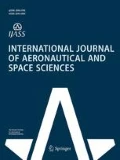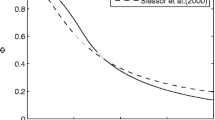Abstract
Shock-wave/boundary-layer interactions (SWBLI) are of great importance in supersonic transport vehicles. The shock-induced separation and its unsteadiness may lead to harmful influences on the aerodynamic performance and fatigue life of supersonic air-intakes, turbo-machine cascades and supersonic nozzles. We particularly focus on a three-dimensional SWBLI in supersonic flow past a finite-span sharp wedge. Implicit large-eddy simulation is performed to investigate the flow features in the three-dimensional SWBLI. Results show that a bow-type side-edge shock wave is generated from the leading edge of the finite-span sharp wedge. The shock impinges on the turbulent boundary layer and causes additional turbulence fluctuations in the spanwise direction. Three-dimensional features dominate the shock impingement and reflection. A large-scale separation bubble is induced by the bow-type side-edge shock wave. Properties of this separation bubble are examined and qualitatively compared with a two-dimensional SWBLI case.














Similar content being viewed by others
References
Dolling DS (2001) Fifty years of shock-wave/boundary-layer interaction research: what next? AIAA J 39(8):1517–1531
Adamson TC, Messiter AF Jr (1980) Analysis of two-dimensional interactions between shock waves and boundary layers. Annu Rev Fluid Mech 12:103–138
Clemens NT, Narayanaswamy V (2009) Shock/turbulent boundary layer interactions: review of recent work on sources of unsteadiness. In: AIAA paper 2009-3710
Andreopoulos Y, Agui JH, Briassulis G (2000) Shock wave-turbulence interactions. Annu Rev Fluid Mech 32:309–345
Clemens NT, Narayanaswamy V (2013) Low-frequency unsteadiness of shock wave/turbulent boundary layer interactions. Annu Rev Fluid Mech 46(1):469–492
Pirozzoli S, Bernardini M (2011) Direct numerical simulation database for impinging shock wave/turbulent boundary-layer interaction. AIAA J 49(6):1307–1312
Ganapathisubramani B, Clemens NT, Dolling DS (2009) Low-frequency dynamics of shock-induced separation in a compression ramp interaction. J Fluid Mech 636:397–425
Piponniau S, Dussauge JP, Debiève JF, Dupont P (2009) A simple model for low-frequency unsteadiness in shock-induced separation. J Fluid Mech 629(6):87–108
Touber E, Sandham ND (2011) Low-order stochastic modelling of low-frequency motions in reflected shock-wave/boundary-layer interactions. J Fluid Mech 671(3):417–465
Morgan B, Duraisamy K, Nguyen N, Kawai S, Lele SK (2013) Flow physics and RANS modelling of oblique shock/turbulent boundary layer interaction. J Fluid Mech 729:231–284
Lu FK, Li Q, Liu C (2012) Micro vortex generators in high-speed flow. J Progr Aerosp Sci 53:30–45
Souverein LJ, Debiève JF (2010) Effect of air jet vortex generators on a shock wave boundary layer interaction. Exp Fluids 49(5):1053–1064
Narayanaswamy V, Laxminarayan LR, Noel TC (2012) Control of unsteadiness of a shock wave/turbulent boundary layer interaction by using a pulsed-plasma-jet actuator. Phys Fluid 24(7):076101
Fang J, Yao Y, Zheltovodov A, Lu L (2017) Investigation of three-dimensional shock wave/turbulent boundary-layer interaction initiated by a single fin. AIAA J 55(2):509–523
Nonomura T, Fujii K (2009) Effects of difference scheme type in high-order weighted compact nonlinear schemes. J Comput Phys 228:3533–3539
Nonomura T, Iizuka N, Fujii K (2010) Freestream and vortex preservation properties of high-order weno and wcns on curvilinear grids. Comput Fluids 39(2):197–214
Nonomura T, Li W, Goto Y, Fujii K (2011) Improvements of efficiency in seventh-order weighted compact nonlinear scheme. CFD J 18(2):180–186
Nishida H, Nonomura T (2009) ADI-SGS scheme on ideal magnetohydrodynamics. J Comput Phys 228:3182–3188
Grinstein FF, Margolin LG, Rider WJ (2007) Implicit large eddy simulation: computing turbulent fluid dynamics. Cambridge University Press, Cambridge
Germano M, Piomelli U, Moin P, Cabot WH (1991) A dynamic subgrid scale eddy viscosity model. Phys Fluids 3(7):1760–1765
Li W, Nonomura T, Fujii K (2013) Mechanism of controlling supersonic cavity oscillations using upstream mass injections. Phys Fluids 25:086101–086115
Li W, Nonomura T, Fujii K (2013) On the feedback mechanism in supersonic cavity flows. Phys Fluids 25:056101–056115
Nonomura T, Fujii K (2011) Overexpansion effects on characteristics of mach waves from a supersonic cold jet. AIAA J 49:2282–2294
Urbin G, Knight D (2001) Large-eddy simulation of a supersonic boundary layer using an unstructured grid. AIAA J 39(7):1288–1295
Comte P, Daude F, Mary I (2008) Simulation of the reduction of unsteadiness in a passively controlled transonic cavity flow. J Fluids Struct 24(8):1252–1261
White F (1974) Viscous fluid flow, chap. 7. McGraw-Hill, New York
Acknowledgements
The authors acknowledge the support of National Natural Science Foundation of China (11202131, 11772194), and the supply of the super computer π in SJTU. Funding was provided by National Basic Research Program of China (973 program) (2014CB744804).
Author information
Authors and Affiliations
Corresponding author
Additional information
Publisher's Note
Springer Nature remains neutral with regard to jurisdictional claims in published maps and institutional affiliations.
Rights and permissions
About this article
Cite this article
Li, W. Three-Dimensional Shock-Wave/Boundary-Layer Interaction in Supersonic Flow Past a Finite-Span Sharp Wedge. Int. J. Aeronaut. Space Sci. 21, 329–336 (2020). https://doi.org/10.1007/s42405-019-00220-2
Received:
Revised:
Accepted:
Published:
Issue Date:
DOI: https://doi.org/10.1007/s42405-019-00220-2




